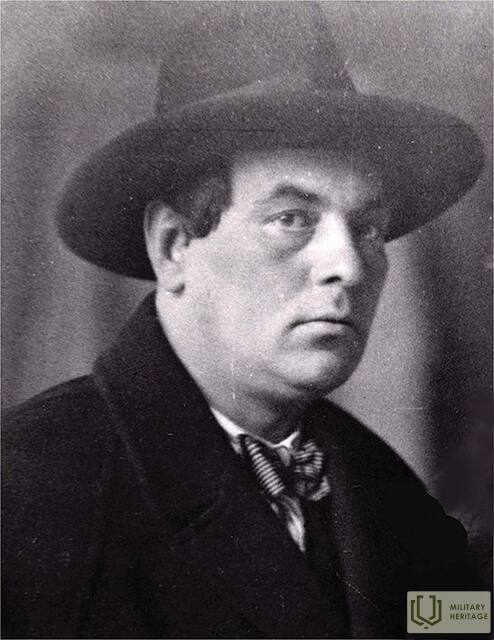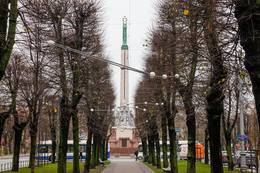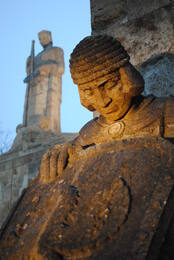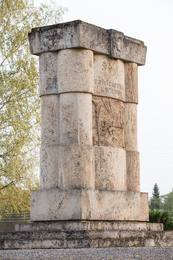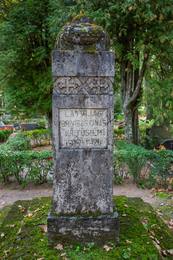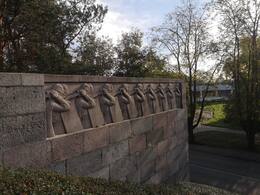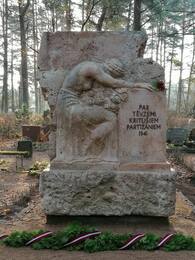Карлис Зале (1888 -1942), скульптор, мастер латышской монументальной скульптуры.
Kārlis Zāle (õige nimega Johans Kārlis Leonhards Zālīte) sündis 28. novembril 1888 Kaunase kubermangus Mažeikiai linnas. Õppis õhtukursustel Liepājas linna joonistus-, stiili- ja maalikoolis, Kaasani kunstikoolis (1909–1913), skulptor Stephan Erzya (Moskva) (1914–1915), keiserlikus kunstiedenduse koolis Petrogradis (1916), Petrogradis kl. Kunstiakadeemia Kõrgem Kunstikool, Petrogradi Riiklikud Vabad Kunstitöökojad. Õppis Berliinis (1921–1923), Itaalias (1926).
Kārlis Zāle märkimisväärsemad tööd on Riia vennaskalmistu skulptuurid ja Vabadussammas. Aastatel 1924–1936 (arhitektid Pēteris Feders, Aleksandrs Birzenieks, aiaarhitekt Andrejs Zeidaks) lõi ta vendade kalmistu ansamblile skulptuuride ja dekoratiivelementide rühmi. Ansamblis on 11 skulptuuri.
Riia vabadussamba jaoks (1931–1935, arhitekt Ernest Stalberg) valmistas Kārlis Zāle Vabaduse allegooria skulptuuri (vase sepistamine, kullamine), obeliski alumist osa katvad rühmad, postamendi nurkades allegoorilised rühmad, kaks reljeefid postamendi tasapindadel terrassi välispindadel.
Kārlis Zāle on valmistanud skulptuurifriisi Sudrabkalniņa Riia rügemendi sõduritele pühendatud mälestussambale Riia kaitsjatele aastal 1919 (1929–1937, arhitekt E. Štālbergs), mälestusmärgile Läti vabadusvõitlustes langenud vendadele. .
Aastatel 1936–1940, aga ka 1941–1942 juhtis Kārlis Zāle Kunstiakadeemia skulptuuritöökoda. Kārlis Zāle oli LU üliõpilasseltsi Concordia Valdemarium liige.
Kārlis Zāle oli Kolme Tähe ordeni suur ohvitser (1935), Isamaa preemia laureaat (1938) ja Läti Kunstiakadeemia auliige (1939).
Kārlis Zāle suri 19. veebruaril 1942 oma kodus Inčukalnsi koguduses "Atvasīte" ja maeti Riia vendade kalmistule.
Дополнительные источники информации
Laila Bremša. Kārlis Zāle. Rahvuslik entsüklopeedia: https://enciklopedija.lv/skirklis/34800
Vaidelotis Apsitis, Vabaduse monument.- Riia, Teadus, 1993.
Vaidelotis Apsitis, Vendade kalmistu, Riia, Teadus.- 1995.
Riia vendade kalmistu. 1915-1936-2011, koost. Guntis Gailitis.- Riia, Jumava, 2011.
Related timeline
Related objects
Памятник Свободы в Риге
Он находится в центре Риги, на площади Бривибас.
Памятник Свободы – один из самых выдающихся памятников истории, архитектуры и искусства Латвии. Он был построен по проекту Карлиса Заалеса на общественные пожертвования. Открыт в 1935 году как символ свободы и любви латышского народа к отечеству. Вместе с ансамблем Могилы рижских братьев он относится к ценнейшим образцам монументальной архитектуры и скульптуры.
Памятник Свободы выражает этические и эстетические ценности латышской культуры. Символы отражают философскую природу свободы и исторические представления латышского народа об этапах борьбы за независимость. Указывает на воплощение физической и душевной силы. Героический язык рассказывает о латышском народе как о самостоятельном, активном творце истории и вершителе своей судьбы.
На его месте изначально стоял памятник русскому царю Петру I. В Первую мировую войну его разобрали для перевозки на корабле в Петроград. Корабль был торпедирован немецкой подводной лодкой и затонул у острова Вормс на территории Эстонии. Советский оккупационный режим несколько раз планировал снести памятник Свободы, но этого не произошло.
Сегодня здесь можно увидеть один из символов Латвии и понаблюдать за традициями армейского почетного караула.
Рижское Братское кладбище
Рижское Братское кладбище находится в Зиемельском районе Риги. Кладбище занимает площадь 9 га и является самым выдающимся и значительным мемориальным ансамблем в Латвии, посвященным павшим латышским воинам. На нём похоронено около 3000 бойцов. Братское кладбище было создано во время Первой мировой войны, когда здесь были похоронены первые трое латышских стрелков, павших в битве с немецкой армией при Тирельпурве. Позже на Братском кладбище захоронили латышских солдат, погибших в других боях и войнах.
Мемориал был спроектирован скульптором Карлисом Зале и является первым подобным ландшафтным, архитектурным и скульптурным ансамблем в Европе. В нем использованы элементы, характерные для латвийского пейзажа, традиционной усадьбы, латышского фольклора и истории, которые прославляют солдат и рассказывают историю солдатского пути. Мемориал, открытый в 1936 году, состоит из трех частей: «Путь раздумий» - аллея длиной 250 м, «Терраса героев» с алтарем Вечного огня и дубовой рощей, а также кладбище, прикрытое латышской стеной, на которой создан образ Матери с павшими сыновьями.
Памятник воинам, погибшим в Освободительной войне
Расположен недалеко от Яунпиебалгской евангелическо-лютеранской церкви Св. Фомы.
Памятник членам Яунпиебалгского прихода, павшим в Освободительной войне, создали скульптор Карлис Зале и архитектор Александр Бирзениекс.
Памятник был открыт 29 июня 1930 года. Его спроектировали скульптор Карлис Зале и архитектор Александрс Бирзениекс, но работы по ковке производились в каменоломне Э. Курау в Риге. Памятник выполнен в виде архитектурной арки. На трехуровневой террасе стоят две колонны со сплошным перекрытием. Между колонн фигурная вкладка - Мать благословляет двух раненых сыновей.
По сообщению Ю. Лисманису учительницы Яунпиебалгской средней школы Весмы Йохансоне, в фундамент памятника заложена урна со списком 125 павших прихожан. В то время в прессе упоминалось всего 60 человек. В этот же день вокруг церкви была посажена «роща героев» - 60 дубов.
Евангелическо-лютеранская церковь св. Фомы в Яунпиебалге была освящена 4 июля 1804 г., но с 1871 по 1873 г. церковь перестраивалась по проекту Матиаса фон Хольста. В нем 800 мест, дубовый алтарь и кафедра. Когда Яунпиебалгская церковь праздновала свое 200-летие, ей было присвоено имя св. Фомы.
Яунпиебалгская церковь, являющаяся памятником культуры государственного значения и крупнейшей лютеранской церковью за пределами Риги, сыграла важную роль в формировании духовного мира многих выдающихся творческих личностей.
Памятники военного наследия на кладбище Дивалиньш в Валмиере
Находится на Валмиерском кладбище Дивала (Яня) в Валмиере.
Можно увидеть памятник из аллажского известняка скульптора Марты Ланге, открытый 26 сентября 1937 года.
Столбчатый памятник замыкает наклонный алтарь, на котором дубовый венок и шлем из известняка.
Похоронено около 80 воинов, погибших в Латвийской войне за независимость, а также умерших от ран и болезней.
Рядом находится одно из малоизвестных произведений Карлиса Зале – памятник «Сломанные розы», связанный с созданием ансамбля Братского кладбища.
Также есть мемориал жертвам коммунистического террора – камень с надписью: «Убийцы коммунистического режима 1941 года» и белые кресты.
Sudrabkalniņš hill - memorial for fight against Bermondt army
Located in Riga, Pardaugava, at the intersection of Sloka and Kurzeme Avenue.
At the beginning of November 1919, during the Latvian War of Independence, street battles between the Latvian Army and Bermont troops took place in Pardaugava. A decisive attack on the Bermont army took place in the area. In 1937, according to the project of Kārlis Zāle, a monument was unveiled in Sudrabkalniņa, honoring the fallen soldiers of the 6th Riga Infantry Regiment and highlighting the military features.
Designed as a memorial wall - a symbolic fortification, the gate of which depicts a lion blocking the path of an opponent's attack. Bricked from the stone blocks of the Daugavgrīva fortress protective wall and forged from the remaining granite of the Freedom Monument. The cost of the memorial site was almost 35,000 lats. For comparison, 4 “Ford - Vairogs V8 De Luxe” cars manufactured in Latvia could be purchased for such an amount.
Today you can see one of the most impressive places of remembrance of the War of Independence.
Monument "Grieving mother" at Inčukalns Cemetery of Honour
Located: Inčukalns district, Inčukalns, Miera street, Inčukalns cemetery.
The monument was unveiled on July 16, 1944. The monument was discovered after the death of K. Zāle. Inscription: On the partisans who fell to the Fatherland in 1941 (restored). The monument was restored on November 5, 2020. The monument was restored with the support of Inčukalns County Council. Restorer artist Igor Dobichin.
Events: “1940. On June 17, Latvia was occupied by the USSR. On June 14, 1941, deportations took place. On June 22, 1941, Germany attacked the USSR and parts of the Wehrmacht entered Latvia. The Red Army and its supporters withdrew. In many places in Latvia - including Ragana, Sēja and Inčukalns - former guards and patriotic young people organized to protect their homes and hurry to expel the Soviet occupiers. When the flag of the Free State of Latvia was hoisted again on July 1, 1941 in the sown parish "Ziediņi", special units of the Red Army at the Northern Cemetery shot the owner of this house - 39-year-old Elza Viša, but on the border of Sēja and Krimulda parish her mother - 64-year-old Elza Martinovu. The residents of the area caused even more hatred and outrage, and they began to gather in the popular resistance movement and form self-defense units, which were also called the first partisans (the leader of the Inčukalns group was Maksis Cālītis). Soldiers and officers who had escaped from the Litene military camp or were released from the so-called Latvian territorial corps also joined the fighters of the county. An armed clash with the Reds took place a few days later, on July 4, seven soldiers and the son of Ragana's pharmacist Pēteris Prašķēvičs fell. In addition, Jānis Porietis, a 17-year-old student of the Rēzekne Teachers' Institute, was injured and captured in the Battle of Ragana and tortured, shot and buried near Straupe.
Here in Inčukalns, a common grave of the brothers was excavated, to which coffins made of white unplaned boards were brought in eight horse-drawn carriages to lay the fallen heroes in their homeland. A few months later, already during the German occupation, a monument was erected in the cemetery by Kārlis Zāle (from 1939 until the end of his life on February 19, 1942, due to a serious illness, the genius Latvian sculptor chose Inčukalns as his residence) - the image of a mourning mother over a rose lap. In the 1950s, local Communist Party activists blew up the monument. The monument was damaged and stagnant until the Awakening, when in the late 80's more and more people became interested and talked about the events of July 4, 1941 and called for the restoration of the monument to Charles Hall. Such a demand was made at the meeting of people and power convened at Inčukalns Primary School on September 8, 1988, which was attended not only by Inčukalns residents, but also by residents of nearby parishes, as well as members of the Environmental Protection Club and LNNK from Riga.
In The people of Inčukalns - Teodors Ildens, Arvīds Blaus, Pēteris Vorfolomējevs -… and many other patriotic people actively participated in the restoration of the monument. On July 4, 1989, in a solemn ceremony, the reborn noble and sad tabby was consecrated by Pastor Vaira Bitena. ”
Memorial places for generals and knights of the Lāčplēsis War Order in Trikāta Parish
The memorial stele is located next to the Trikāta cemetery chapel.
Trikāta Cemetery preserves the memory of three outstanding Latvian generals - Roberts Dambītis, Kārlis Goppers and Jānis Balodis. Jēkabs Mūrnieks, a teacher of all these generals, is also buried in Trikāta cemetery.
The generals and the knights of the Lāčplēsis Military Order are commemorated every year with torchlight processions to the Trikāta cemetery, where there are two memorial statues, in which the names of 17 knights of the Lāčplēsis Military Order associated with Trikāta parish are engraved.
Stela was opened on November 11, 2018.
Video story about the Lāčplēsis War Order and the set of orders that belonged to General Jānis Balodis.
Связанные истории
Oskarui Kalpakui atminti
Oskaro Kalpako atminimas saugomas daug kur – tai liudija jo gimtasis Liepsalu namas, paminklas Visagalos kapinėse, atminimo renginiai ir gražūs Kovo 6-osios koncertai, Meirānu Kalpako pagrindinė mokykla, gatvės Lubanoje, Madonoje ir kituose miestuose ir toliau. Bet šiame straipsnyje – apie Oskaro Kalpako atminimo išsaugojimą gimtinėje XX amžiaus 2–3 dešimtmetyje. metų.




